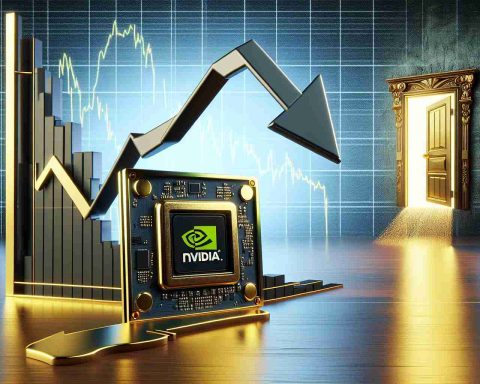- Micron Technology’s stock surged 11.7% amid general market gains, driven by optimism around artificial intelligence advancements.
- Investor enthusiasm is fueled by Nvidia’s demand for advanced hardware and the potential integration of Micron’s solutions in new devices.
- Foxconn Technology achieved its highest-ever quarterly revenue, partly due to increased AI server orders from Nvidia, highlighting Micron’s key role in Nvidia’s platforms.
- Nvidia’s upcoming GB300 processor promises advancements and may continue their successful collaboration with Micron.
- Micron faces challenges from the cyclical memory chip market but maintains a positive long-term outlook with significant growth in the High Bandwidth Memory market projected.
- Strategic partnerships with AI leaders position Micron for future success despite current market volatility.
Micron Technology recently turned the spotlight on itself with an impressive stock surge, climbing a staggering 11.7% in a climate of general market gains. This acceleration aligns perfectly with the uplifting ambiance in major indices such as the S&P 500 and Nasdaq Composite. However, it’s the buzz around Nvidia—the futuristic powerhouse in artificial intelligence—that is infusing new energy into Micron’s trajectory.
Amidst this excitement, investors are electrified by Nvidia’s unyielding demand for cutting-edge hardware, building anticipation for their CEO’s potential unveiling of new devices. These might integrate Micron’s trailblazing solutions, thus further intertwining their tech destinies. Adding another layer of intrigue, Foxconn Technology, a significant electronics manufacturer, hailed its highest-ever quarterly revenue. This spike is thanks to a surge in AI server orders, with Nvidia as a major client, underscoring Micron’s critical role in Nvidia’s Blackwell series platforms.
Industry insiders eagerly await details from Nvidia’s CEO regarding their upcoming GB300 processor, promising robust improvements over its predecessor and likely continuing the fruitful partnership with Micron. As the memory chip giant gears up for this potential collaboration, challenges inherent to the cyclical memory chip market loom.
Despite recent gains, Micron’s stock is still below last year’s peak. However, the long-term forecast remains optimistic. As the High Bandwidth Memory (HBM) market is expected to balloon from $16 billion in 2024 to a whopping $100 billion by 2030, Micron is strategically positioned to harness this growth opportunity.
The key takeaway? Micron’s fusion with AI innovators like Nvidia reaffirms its promising future, despite market fluctuations. The road ahead shines with potential, as Micron maneuvers through challenges and leverages strategic alliances.
Is Micron Positioned to Lead the AI Revolution with Cutting-Edge Innovations?
Market Forecasts
Micron Technology’s recent stock surge signals its critical role in the evolving AI landscape, potentially riding the wave of climbing demand in the High Bandwidth Memory (HBM) market. According to forecasts, the HBM market is slated to inflate from a $16 billion valuation in 2024 to an astonishing $100 billion by 2030, creating fertile ground for Micron’s strategic expansion and innovation. This growth underpins industry confidence in Micron’s ability to capitalize on AI-driven technological transformations.
Innovation Insights
The alliance between Micron and Nvidia highlights a pivotal moment in AI advancement, suggesting that Micron’s sophisticated memory solutions might power Nvidia’s anticipated GB300 processor. This next-gen processor is expected to offer significant performance boosts and could solidify the partnership’s standing as a dynamic duo in tech innovation. Micron’s pioneering efforts in DRAM and NAND technology are likely to play a crucial role in Nvidia’s AI-centric product ecosystem, indicating a symbiotic relationship driving forward AI capabilities.
Controversies and Challenges
Despite the optimistic outlook and strategic partnerships, Micron faces inherent challenges typical of the cyclical nature of the memory chip market. These include fluctuating supply and demand dynamics, pricing pressures, and evolving technology requirements. Another layer of complexity is added by geopolitical tensions and trade policy shifts, which could impact supply chains and sourcing strategies, influencing both production costs and market access.
Key Questions and Answers
1. What are Micron’s chances of sustaining growth in the volatile memory chip market?
Micron’s growth sustainability hinges on its ability to adapt to market shifts and leverage strategic partnerships like the one with Nvidia. By focusing on advanced technologies like HBM and maintaining a strong pipeline of innovation, Micron stands a good chance of mitigating risks associated with market cyclicality.
2. How might Nvidia’s GB300 processor impact Micron’s market position?
Nvidia’s GB300 processor, likely integrating Micron’s memory solutions, may significantly enhance Micron’s market stature by showcasing the practical applications of its technologies in cutting-edge AI products. This collaboration could spearhead new industry standards, bolstering Micron’s reputation as a critical contributor to AI advancements.
3. Could geopolitical issues affect Micron’s collaboration with Nvidia and its market performance?
Yes, geopolitical tensions and shifts in trade policies pose potential risks to Micron’s supply chains and international collaborations. Staying agile and proactive in navigating these developments, while investing in diverse sourcing and resilient supply strategies, will be vital for maintaining robust collaboration dynamics with Nvidia and securing market stability.
For further insights, visit Micron Technology and Nvidia.




















